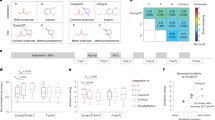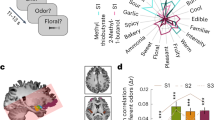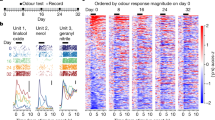Abstract
Ongoing sensory input is critical for shaping internal representations of the external world. Conversely, a lack of sensory input can profoundly perturb the formation of these representations. The olfactory system is particularly vulnerable to sensory deprivation, owing to the widespread prevalence of allergic, viral and chronic rhinosinusitis, but how the brain encodes and maintains odor information under such circumstances remains poorly understood. Here we combined functional magnetic resonance imaging (fMRI) with multivariate (pattern-based) analyses and psychophysical approaches to show that a 7-d period of olfactory deprivation induces reversible changes in odor-evoked fMRI activity in piriform cortex and orbitofrontal cortex (OFC). Notably, multivoxel ensemble codes of odor quality in OFC became decorrelated after deprivation, and the magnitude of these changes predicted subsequent olfactory perceptual plasticity. Our findings suggest that transient changes in these key olfactory brain regions are instrumental in sustaining odor perception integrity in the wake of disrupted sensory input.
This is a preview of subscription content, access via your institution
Access options
Subscribe to this journal
Receive 12 print issues and online access
$209.00 per year
only $17.42 per issue
Buy this article
- Purchase on Springer Link
- Instant access to full article PDF
Prices may be subject to local taxes which are calculated during checkout





Similar content being viewed by others
References
Wiesel, T.N. & Hubel, D.H. Single-cell responses in striate cortex of kittens deprived of vision in one eye. J. Neurophysiol. 26, 1003–1017 (1963).
Van der Loos, H. & Woolsey, T.A. Somatosensory cortex: structural alterations following early injury to sense organs. Science 179, 395–398 (1973).
Merzenich, M.M. et al. Somatosensory cortical map changes following digit amputation in adult monkeys. J. Comp. Neurol. 224, 591–605 (1984).
Hubel, D.H. & Wiesel, T.N. The period of susceptibility to the physiological effects of unilateral eye closure in kittens. J. Physiol. (Lond.) 206, 419–436 (1970).
Linkenhoker, B.A. & Knudsen, E.I. Incremental training increases the plasticity of the auditory space map in adult barn owls. Nature 419, 293–296 (2002).
Scheiman, M.M. et al. Randomized trial of treatment of amblyopia in children aged 7 to 17 years. Arch. Ophthalmol. 123, 437–447 (2005).
Li, W., Howard, J.D., Parrish, T.B. & Gottfried, J.A. Aversive learning enhances perceptual and cortical discrimination of indiscriminable odor cues. Science 319, 1842–1845 (2008).
Li, W., Luxenberg, E., Parrish, T. & Gottfried, J.A. Learning to smell the roses: experience-dependent neural plasticity in human piriform and orbitofrontal cortices. Neuron 52, 1097–1108 (2006).
Hofer, S.B., Mrsic-Flogel, T.D., Bonhoeffer, T. & Hubener, M. Prior experience enhances plasticity in adult visual cortex. Nat. Neurosci. 9, 127–132 (2006).
Wilson, D.A. & Wood, J.G. Functional consequences of unilateral olfactory deprivation: time-course and age sensitivity. Neuroscience 49, 183–192 (1992).
Maruniak, J.A., Taylor, J.A., Henegar, J.R. & Williams, M.B. Unilateral naris closure in adult mice: atrophy of the deprived-side olfactory bulbs. Brain Res. Dev. Brain Res. 47, 27–33 (1989).
Corotto, F.S., Henegar, J.R. & Maruniak, J.A. Odor deprivation leads to reduced neurogenesis and reduced neuronal survival in the olfactory bulb of the adult mouse. Neuroscience 61, 739–744 (1994).
Best, A.R. & Wilson, D.A. A postnatal sensitive period for plasticity of cortical afferents but not cortical association fibers in rat piriform cortex. Brain Res. 961, 81–87 (2003).
Livneh, Y. & Mizrahi, A. Experience-dependent plasticity of mature adult-born neurons. Nat. Neurosci. 15, 26–28 (2012).
Boroojerdi, B. et al. Enhanced excitability of the human visual cortex induced by short-term light deprivation. Cereb. Cortex 10, 529–534 (2000).
Pitskel, N.B., Merabet, L.B., Ramos-Estebanez, C., Kauffman, T. & Pascual-Leone, A. Time-dependent changes in cortical excitability after prolonged visual deprivation. Neuroreport 18, 1703–1707 (2007).
Pantev, C., Wollbrink, A., Roberts, L.E., Engelien, A. & Lutkenhoner, B. Short-term plasticity of the human auditory cortex. Brain Res. 842, 192–199 (1999).
Rossini, P.M. et al. Short-term brain 'plasticity' in humans: transient finger representation changes in sensory cortex somatotopy following ischemic anesthesia. Brain Res. 642, 169–177 (1994).
Sireteanu, R., Oertel, V., Mohr, H., Linden, D. & Singer, W. Graphical illustration and functional neuroimaging of visual hallucinations during prolonged blindfolding: a comparison to visual imagery. Perception 37, 1805–1821 (2008).
Merabet, L.B. & Pascual-Leone, A. Neural reorganization following sensory loss: the opportunity of change. Nat. Rev. Neurosci. 11, 44–52 (2010).
Lledo, P.M. & Saghatelyan, A. Integrating new neurons into the adult olfactory bulb: joining the network, life-death decisions, and the effects of sensory experience. Trends Neurosci. 28, 248–254 (2005).
Graziadei, P.P. & Graziadei, G.A. Neurogenesis and neuron regeneration in the olfactory system of mammals. I. Morphological aspects of differentiation and structural organization of the olfactory sensory neurons. J. Neurocytol. 8, 1–18 (1979).
Weiler, E. & Farbman, A.I. Proliferation in the rat olfactory epithelium: age-dependent changes. J. Neurosci. 17, 3610–3622 (1997).
Angely, C.J. & Coppola, D.M. How does long-term odor deprivation affect the olfactory capacity of adult mice? Behav. Brain Funct. 6, 26 (2010).
Guthrie, K.M., Wilson, D.A. & Leon, M. Early unilateral deprivation modifies olfactory bulb function. J. Neurosci. 10, 3402–3412 (1990).
Hunt, N.L. & Slotnick, B.M. Functional capacity of the rat olfactory bulb after neonatal naris occlusion. Chem. Senses 16, 131–142 (1991).
Kim, H.H., Puche, A.C. & Margolis, F.L. Odorant deprivation reversibly modulates transsynaptic changes in the NR2B-mediated CREB pathway in mouse piriform cortex. J. Neurosci. 26, 9548–9559 (2006).
Wilson, D.A., Best, A.R. & Brunjes, P.C. Trans-neuronal modification of anterior piriform cortical circuitry in the rat. Brain Res. 853, 317–322 (2000).
Wilson, D.A. & Sullivan, R.M. The D2 antagonist spiperone mimics the effects of olfactory deprivation on mitral/tufted cell odor response patterns. J. Neurosci. 15, 5574–5581 (1995).
Brunjes, P.C. & Borror, M.J. Unilateral odor deprivation: differential effects due to time of treatment. Brain Res. Bull. 11, 501–503 (1983).
Luskin, M.B. & Price, J.L. The topographic organization of associational fibers of the olfactory system in the rat, including centrifugal fibers to the olfactory bulb. J. Comp. Neurol. 216, 264–291 (1983).
Friston, K.J., Penny, W.D. & Glaser, D.E. Conjunction revisited. Neuroimage 25, 661–667 (2005).
Nichols, T., Brett, M., Andersson, J., Wager, T. & Poline, J.B. Valid conjunction inference with the minimum statistic. Neuroimage 25, 653–660 (2005).
Esterman, M., Tamber-Rosenau, B.J., Chiu, Y.C. & Yantis, S. Avoiding non-independence in fMRI data analysis: leave one subject out. Neuroimage 50, 572–576 (2010).
Worsley, K.J. et al. A unified statistical approach for determining significant signals in images of cerebral activation. Hum. Brain Mapp. 4, 58–73 (1996).
Howard, J.D., Plailly, J., Grueschow, M., Haynes, J.D. & Gottfried, J.A. Odor quality coding and categorization in human posterior piriform cortex. Nat. Neurosci. 12, 932–938 (2009).
Rolls, E.T., Grabenhorst, F. & Parris, B.A. Neural systems underlying decisions about affective odors. J. Cogn. Neurosci. 22, 1069–1082 (2010).
Zelano, C., Mohanty, A. & Gottfried, J.A. Olfactory predictive codes and stimulus templates in piriform cortex. Neuron 72, 178–187 (2011).
Illig, K.R. Projections from orbitofrontal cortex to anterior piriform cortex in the rat suggest a role in olfactory information processing. J. Comp. Neurol. 488, 224–231 (2005).
Cohen, Y., Reuveni, I., Barkai, E. & Maroun, M. Olfactory learning-induced long-lasting enhancement of descending and ascending synaptic transmission to the piriform cortex. J. Neurosci. 28, 6664–6669 (2008).
Carmichael, S.T., Clugnet, M.C. & Price, J.L. Central olfactory connections in the macaque monkey. J. Comp. Neurol. 346, 403–434 (1994).
Schoenbaum, G. & Eichenbaum, H. Information coding in the rodent prefrontal cortex. II. Ensemble activity in orbitofrontal cortex. J. Neurophysiol. 74, 751–762 (1995).
Critchley, H.D. & Rolls, E.T. Olfactory neuronal responses in the primate orbitofrontal cortex: analysis in an olfactory discrimination task. J. Neurophysiol. 75, 1659–1672 (1996).
Roesch, M.R., Stalnaker, T.A. & Schoenbaum, G. Associative encoding in anterior piriform cortex versus orbitofrontal cortex during odor discrimination and reversal learning. Cereb. Cortex 17, 643–652 (2007).
van Wingerden, M., Vinck, M., Lankelma, J. & Pennartz, C.M. Theta-band phase locking of orbitofrontal neurons during reward expectancy. J. Neurosci. 30, 7078–7087 (2010).
Plailly, J., Howard, J.D., Gitelman, D.R. & Gottfried, J.A. Attention to odor modulates thalamocortical connectivity in the human brain. J. Neurosci. 28, 5257–5267 (2008).
Waggener, C.T. & Coppola, D.M. Naris occlusion alters the electro-olfactogram: evidence for compensatory plasticity in the olfactory system. Neurosci. Lett. 427, 112–116 (2007).
Korol, D.L. & Brunjes, P.C. Rapid changes in 2-deoxyglucose uptake and amino acid incorporation following unilateral odor deprivation: a laminar analysis. Brain Res. Dev. Brain Res. 52, 75–84 (1990).
Philpot, B.D., Foster, T.C. & Brunjes, P.C. Mitral/tufted cell activity is attenuated and becomes uncoupled from respiration following naris closure. J. Neurobiol. 33, 374–386 (1997).
Holbrook, E.H. & Leopold, D.A. An updated review of clinical olfaction. Curr. Opin. Otolaryngol. Head Neck Surg. 14, 23–28 (2006).
Hilberg, O. Objective measurement of nasal airway dimensions using acoustic rhinometry: methodological and clinical aspects. Allergy 57 (suppl. 70): 5–39 (2002).
Hasegawa, M. & Kern, E.B. The human nasal cycle. Mayo Clin. Proc. 52, 28–34 (1977).
Doty, R.L., Shaman, P., Kimmelman, C.P. & Dann, M.S. University of Pennsylvania Smell Identification Test: a rapid quantitative olfactory function test for the clinic. Laryngoscope 94, 176–178 (1984).
Hummel, T., Sekinger, B., Wolf, S.R., Pauli, E. & Kobal, G. 'Sniffin' Sticks': olfactory performance assessed by the combined testing of odor identification, odor discrimination and olfactory threshold. Chem. Senses 22, 39–52 (1997).
Bartoshuk, L.M. The psychophysics of taste. Am. J. Clin. Nutr. 31, 1068–1077 (1978).
Finnell, J.T., Knopp, R., Johnson, P., Holland, P.C. & Schubert, W. A calibrated paper clip is a reliable measure of two-point discrimination. Acad. Emerg. Med. 11, 710–714 (2004).
Benton, A.L., Varney, N.R. & Hamsher, K.D. Visuospatial judgment. A clinical test. Arch. Neurol. 35, 364–367 (1978).
Gottfried, J.A., Deichmann, R., Winston, J.S. & Dolan, R.J. Functional heterogeneity in human olfactory cortex: an event-related functional magnetic resonance imaging study. J. Neurosci. 22, 10819–10828 (2002).
Gottfried, J.A. & Zald, D.H. On the scent of human olfactory orbitofrontal cortex: meta-analysis and comparison to non-human primates. Brain Res. Brain Res. Rev. 50, 287–304 (2005).
Mai, J.K., Assheuer, J. & Paxinos, G. Atlas of the Human Brain viii (Academic Press, San Diego, 1997).
Acknowledgements
The authors would like to thank M. Cahill for assistance in nasal endoscopy and acoustic rhinometry measurements, N. Sandalow and K. Phillips for technical assistance and data collection, and S. Warrenburg (International Flavors and Fragrances) for providing the odorless grade solvents. This work was supported by Northwestern Institutional Predoctoral Training Awards to K.N.W. (T32NS047987) and to J.D.H. (2T32 MH067564), grants R01DC010014 and K08DC007653 from the US National Institute on Deafness and Other Communication Disorders to J.A.G., and US National Institutes of Health grant M01-RR00048 from the National Center for Research Resources to Northwestern University Feinberg School of Medicine.
Author information
Authors and Affiliations
Contributions
J.A.G. conceived the experiment, with extensive contributions and methodological suggestions from K.N.W., D.B.C. and J.D.H. K.N.W. collected the imaging and behavioral data. D.B.C. and B.K.T. collected and analyzed the nasal endoscopy and rhinometry data. K.N.W. analyzed the behavioral and imaging data with assistance from J.D.H. and J.A.G. K.N.W., J.D.H. and J.A.G. wrote the manuscript.
Corresponding authors
Ethics declarations
Competing interests
The authors declare no competing financial interests.
Supplementary information
Supplementary Text and Figures
Supplementary Figures 1–5 and Supplementary Tables 1–2 (PDF 225 kb)
Rights and permissions
About this article
Cite this article
Wu, K., Tan, B., Howard, J. et al. Olfactory input is critical for sustaining odor quality codes in human orbitofrontal cortex. Nat Neurosci 15, 1313–1319 (2012). https://doi.org/10.1038/nn.3186
Received:
Accepted:
Published:
Issue Date:
DOI: https://doi.org/10.1038/nn.3186
This article is cited by
-
Decreased activity of piriform cortex and orbitofrontal hyperactivation in Usher Syndrome, a human disorder of ciliary dysfunction
Brain Imaging and Behavior (2022)
-
Acquired olfactory loss alters functional connectivity and morphology
Scientific Reports (2021)
-
Olfactory signals from the main olfactory bulb converge with taste information from the chorda tympani nerve in the agranular insular cortex of rats
Pflügers Archiv - European Journal of Physiology (2020)
-
An intrinsic association between olfactory identification and spatial memory in humans
Nature Communications (2018)
-
Impaired brain response to odors in patients with varied severity of olfactory loss after traumatic brain injury
Journal of Neurology (2018)



